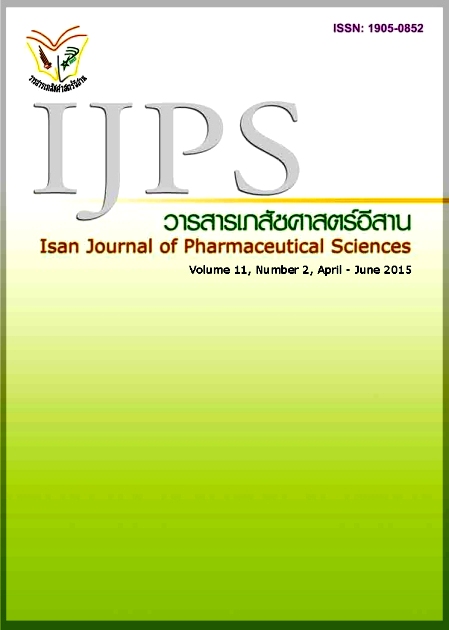Development of Identity Testing for Monoclonal Antibodies using Capillary Isoelectric Focusing Method
Main Article Content
Abstract
Currently, many monoclonal antibodies produced by biotechnology are imported to Thailand. As protein drugs, their manufacturing process are complex; if quality control is inadequately performed, the drugs’ quality would be inconsistent. When isoforms occur, they may affect drug efficacy and safety. Therefore, capillary isoelectric focusing (cIEF) was developed as identity testing based on isoelectric point (pI) differences of protein molecules. Materials and method: Validation of cIEF using PA 800 Beckman Coulter PA 800 was performed and protein drugs; monoclonal antibody including granulocyte colony stimulating factor (G-CSF) were used. Results: The validated conditions offered good separation of monoclonal antibodies from peptide markers as well as G-CSF, their specific pIs were shown. The results of both repeatability and reproducibility were precise; percent relative standard deviation (%RSD) for pIs of the main peaks was less than 0.3. Besides, this cIEF method was also robust; changes of analysts, a new capillary as well as a new lot of ampholyte did not affect its accuracy, the %RSDs for pIs of all the main peaks were less than 0.9. The identity test of monoclonal antibodies using this validated method gave comparable results to their reference materials including their pIs and peak patterns. Conclusion: Therefore, this cIEF method is suitable to use as one of the identity testing methods for quality control of monoclonal antibodies before and after being marketed in Thailand.
Article Details
In the case that some parts are used by others The author must Confirm that obtaining permission to use some of the original authors. And must attach evidence That the permission has been included
References
Dubel S. Recombinant therapeutic antibodies. Appl Microbiol Biotechnol 2007; 74: 723-29.
European Directorate for the Quality of Medicine & HealthCare (EDQM). European Pharmacopoeia 2011 volume I. Nördlingen: Druckerei C.H. Beck; 2010; 77-82.
European Directorate for the Quality of Medicine & HealthCare (EDQM). European Pharmacopoeia, 2011 volume I. Nördlingen: Druckerei C.H. Beck; 2010: 692-3.
FDA. Food and Drug Administration. http://drug.fda.moph.go.th/zone_service/ser020.asp.
Hunt G, Hotaling T, Chen AB. Validation of a capillary isoelectric focusing method for the recombinant monoclonal antibody C2B8. J Chromatogr A. 1998; 800:355–67.
Hunt G., Moorhouse KG, Chen AB. Capillary isoelectric focusing and sodium dodecyl sulfate-capillary gel electrophoresis of recombinant humanized monoclonal antibody HER2. J Chromatogr A 1996; 744 (1-2): 295-301.
Jefferis R. Recombinant antibody therapeutics: the impact of glycosylation on mechanisms of action. Trends Pharmacol Sci 2009; 30(7): 356-62.
Jenkins MA, Ratnaike S. Capillary isoelectric focusing of haemoglobin variants in the clinical laboratory. Clinica Chimica Acta 1999; 289: 121–132.
Kindt TJ, Goldsby RA, Osborne BA. editors. Kuby IMMUNOLOGY. 6th edition. New York: W.H. Freeman and Company. 2006; 85-9.
Little MJ, Paquette DM, Roos PK. Electrophoresis of pharmaceutical proteins: Status quo. Electrophoresis 2006; 27(12): 2477–2485.
Mack S, Cruzado-Park, ID, Ratnayake CK, Application Information Bulletin A-12026 A: High Resolution cIEF of Therapeutic Monoclonal Antibodies: A Platform Method Covering pH 4-10, Beckman Coulter, Inc., Fullerton, CA, 2008. [cited 2013 December 16]. Available from: https://www.beckmancoulter.com/wsrportal/bibliography?docname=A-12026A.pdf.
Maeda E., Urakami K., Shimura K., et al. Charge heterogeneity of a therapeutic monoclonal antibody conjugated with a cytotoxic antitumor antibiotic, calicheamicin. J Chromatogr A 2010; 1217: 7164–7171. Pharmacopoeia Convention. The United States Pharmacopoeia, the National Formulary: USP 36, NF 31 2013. United States Pharmacopoeia Convention. Rockville (MD): The United States Pharmaceutical Convention; 2013. 629-632.
Pharmacopoeia Convention. The United States Pharmacopoeia, the National Formulary: USP 36, NF 31 2013. United States Pharmacopoeia Convention. Rockville (MD): The United States Pharmaceutical Convention; 2013. 551.
Righetti PG. Determination of the isoelectric point of proteins by capillary isoelectric focusing. J Chromatogr A 2004; 1037: 491–99.
Roche. Biotechnology - New Directions in Medicine. 3rd edition. Basel: F. Hoffmann-La Roche Ltd. 2008.
Santora LC, Krull IS, Gran KT. Characterization of Recombinant Human Monoclonal Tissue Necrosis Factor-α Antibody Using Cation-Exchange HPLC and Capillary Isoelectric Focusing. Analytical Biochemistry 1999; 275: 98–08.
Shukla AA, Thommes J. Recent Advances in Large-Scale Production of Monoclonal Antibodies and Related Proteins. Trends Biotechnol 2010; 28(5): 253-61.
Sosic XZ, Krull IS. Capillary isoelectric focusing as a tool in the examination of antibodies, peptides and proteins of pharmaceutical interest. J Chromatogr 1996; 735:165-90.
Tang S, Nesta DP, Maneri LR, Anumula KR. A method for routine analysis of recombinant immunoglobulins (rIgGs) by capillary isoelectric focusing (cIEF). J Pharm Biomed Anal 1999; 19(3-4) 569–83.
World Health Organization. WHO Technical Report Series No. 977. World Health Organization. Geneva. 2013; 51-89.
Zhao SS, Chen DY. Applications of capillary electrophoresis in characterizing recombinant protein therapeutics Electrophoresis 2014; 35(1): 96–108.
Zhou GH, Luo GA, Sun GQ, Cao YC, Zhang XD, Zhang X. Characterization of recombinant human granulocyte colony stimulating factor (rHuG-CSF) by capillary zone electrophoresis, capillary isoelectric
focusing electrophoresis and electrospray ionization mass spectrometry. J Pharm Biomed Anal 2004; 35(3):425-32.


